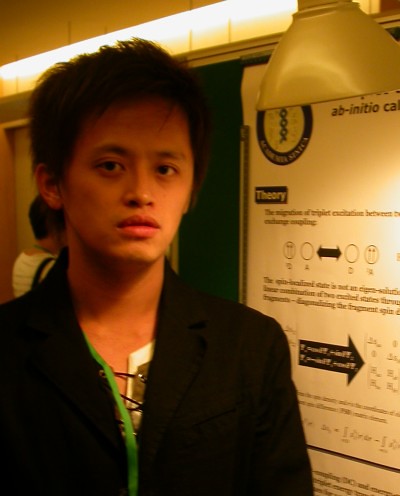Non-photochemical quenching - is the molecular mechanism illuminated by the high resolution crystal structures of light-harvesting complex II ?
The photosynthetic systems in higher plant efficiently utilizes low intensity of sunlight in shade and avoids oxidative damage to the photosynthetic apparatus under excess light condition. The latter is known as non-photochemical quenching (NPQ) which can be measured in vivo as a reduction in the yield of chlorophyll fluorescence. This quenching is a complex process over a range of different time scales. One fast component (qE) of NPQ has been associated with the lowering of the pH in the thylakoid lumen side, induction of the xanthophyll cycle, the presence of the PsbS protein and conformation change of light-harvesting complex II (LHCII) [1-5]. However, the molecular mechanism for NPQ is still not clear. Recent high-resolution crystals of LHCII [6-7] have been found in the quenched state and might provide molecule-based solution for NPQ. In my presentation, I am going to report the work by Pascal et al. (see the attachment). Their spectra data showed the evidence of conformation change in quenched LHCII and two possible quenching sites are addressed. Furthermore, my different point view to this paper and the demand of theoretical study will be given in this presentation.
Horton, P. et al. (1996) Regulation of light-harvesting in green plants. Annu. Rev. Plant Physiol. 47, 665-684
Horton, P. et al. (2000) Allosteric regulation of the light-harvesting system of photosysmte II. Phil. Trans. R. Soc. Lond. B 355, 1361-1370
Niyogi K. K. et al. (2001) Non-photochemical quenching. A response to excess light energy. Plant Physiology 125, 1558-1566
Li, X. P. et al. (2000) A pigment-binding protein essential for regulation of photosynthetic light-harvesting. Nature 403, 391-395
Demmig-Adams, B. (1990) Carotenoids and photoprotection: a role for the xanthophyll zeaxanthin. Biochim. Biophys. Acta 1020, 1-24
Liu, Z. et al. (2004) Crystal structure of spinach major light-harvesting complex at 2.72A resolution. Nature 428, 287-292
Standfuss, J. et al. (2005) Mechanisms of photoprotection and nonphotochemical quenching in pea light-harvesting complex at 2.5A resolution. EMBO J. 24, 919-928
The overall time cost for releasing oxygen and protons is around 20ms.
PQ pool release 2 protons around 5ms.
fluorescence lifetime in LHCII, PSII, and vivo
LHCII-trimer: 4ns
LHCII-oligomer: 0.2-1.5ns (Moya, I, BIOCHEM40; Mullineaux, CW, BBA1141)
LHCII-oligomer: 0.65ns (by FLIM)
LHCII-crystal (plane?): 0.89ns (by FLIM)
the way to induce conformation changes of light-harvesting complexes (LHCII), which result in wanted highly energy dissipating state.
literal aggregation in the membrane plane
perpendicularly stacking to the membrane plane
other non-LHCII proteins presented
lipid-environment presented
outline
- photochemistry in photosynthetic apparatus
harvesting sunlight safely (materials from Nature paper by Demmig-Adams, Babara)
chlorophyll fluorescence
non-photochemical quenching (introduction to three kinds of NPQ and focus on qE which is dependent on the gradient of pH and the xanthophyll cycle)
slow component of qE
fast component of qE
structure related to fast one (chlorophyll self-quenching ?)

0 comments:
Post a Comment